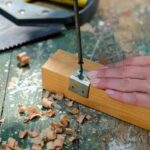Introduction
Woodworking joints play an important role in the strength and stability of a furniture piece or structure. Different types of joints, such as butt joints, miter joints, scarf joints and dowel joints, each have unique strengths and benefits.
Butt joints are two pieces of wood cut to fit end-to-end with no overlap, creating a straight joint. They are strong enough for most applications but can be reinforced with screws or pins for extra strength. Miter joints require two pieces of wood end-at-angle, creating an angled joint when joined together. They are often used on doors and window frames but need to be reinforced as they are not as strong as other types of woodworking joints. Scarf joints allow two pieces of wood to join at a diagonal angle, maximizing surface area contact between the two pieces to create one solid connection. The angles used in these joint helps provide greater durability over straight connections in materials like plywood or veneer that would otherwise lack the tensile strength required for wooden structures. Dowel joins use small cylindrical pegs placed inside bored holes to connect two pieces of wood together at right angles. This creates a tight connection that is incredibly strong and efficient; however, it requires precise measurement for accuracy as even small differences can affect the strength of the joint negatively.
Overall, choosing the best type of joint for your project depends on what kind of material you’re working with and how much strength you want it to have. Making sure that Joints are properly cut and secured is key for maximum durability in any kind of wooden construction project – whether it’s commercial furniture production or home DIY projects.
Half-Lap Joints
Half-lap joints are one of the strongest and most versatile woodworking joints. They can be used in a wide variety of applications, from simple furniture construction to advanced cabinetry projects. Half-lap joints are easy to make and provide a snug fit with obvious aesthetic appeal. The joint relies on overlapping sections of wood that partially cut away on two matching ends; these ends interlock when attached and secured with screws or nails. This allows the two pieces of wood to join together seamlessly, providing an incredibly strong joint.
These types of joints have an inherent strength and stability because they span the entire length of the material being joined and rely on multiple contact points between parts. As long as they are properly made, half-lap joints rarely fail even under extreme conditions such as high heat or moisture levels. In addition, due to their overlap design, the joint provides additional stability along its length and reduces material waste associated with other common woodworking joints such as miter or dovetail cuts which often require measuring exact lengths for cutting material down for fitment.
Due to their looks alone half-lap joints can greatly enhance the appearance of your finished project; no matter if it’s a birdhouse or your own custom dining room table set – half lap joints create angles that look complicated but in reality are quite simple to construct. A well-crafted lap joint looks more professional than other more traditional joins like biscuits, dowels, pocket hole joinery or butt joins which often leave marks that stand out against the natural beauty of grain patterns in different types of wood species.
Dovetail Joints
The dovetail joint is a principle example of strength and beauty coming together. Used by wood joiners in centuries past, and still prevalent in contemporary furniture craftsmanship, this joint embodies a secure interlocking fit that provides remarkable durability and stability. Using both wood glue and mechanical fastening elements such as pegs or screws, dovetails will hold up to various stresses in countless high-functioning applications.
This strength comes from the connection of adjacent pins that form from angled saw cuts in both the tail boards (male portion) and pin boards (female portion). Together with these angled surfaces, this “interference” fit prevents the dovetail joint from being pulled apart without damaging or compromising it. Additionally, due to its precision nature, this method of joinery can be ideal for showpieces that require flush appearances. Although slightly more time consuming than other methods of Woodworking joints, Dovetails can provide superior strength and aesthetics desired for intricate projects where details matter most.
Mortise and Tenon Joints
Mortise and Tenon joints are one of the oldest and strongest woodworking joints used in furniture making. The joint consists of a square or rectangular hole, referred to as a mortise that is cut into one piece of wood and a tongue-shaped tenon cut on the end of another piece of wood, which fits snugly inside the mortise. When secured with glue, wedges, or pins, Mortise and Tenon joints can be exceptionally strong and provide superior holding power for two pieces of wood mated together at right angles.
This classic joint has sustained the test of time as an essential part in wooden furniture around the globe for centuries. It requires precision craftsmanship in order to be assembled correctly, with each mortise fitting snugly into its corresponding tenon to form an exact fit for maximum strength. Additionally, wedges, dowels or other fasteners can be inserted through either end to further secure the joint from shifting or loosening. In situations where an even stronger joinery is needed, screws may also be applied through the longer tenon into the mortise thus creating a reinforced union between the two materials. By combining all these reinforcing techniques together it is possible to create exceptionally strong Mortase and Tenon joints capable of amplifying your projects strength while minimizing stress points that could otherwise lead to failure over time.
Pocket Hole Joints
Pocket hole joints are one of the strongest and most reliable woodworking joints available. They’re used to join two pieces of wood together in a variety of applications, such as cabinetry, furniture assembly and more. Typically, pocket hole joints involve using a jig to drill holes into each piece of wood at an angle. These angle holes create “pockets” where hardware such as screws can be inserted and tightened to secure the pieces together.
The strength of pocket hole joints comes from how tight the two pieces fit together. When putting your project together, make sure you use properly sized drill bits for the type of wood you are working with so that your holes won’t be too large for the screw or other hardware you wish to use. Another key factor is that the screws must penetrate far enough into each piece in order to reach its “pocket” on the other side – improper placement will result in a weak joint! If done correctly however, pocket hole joints offer a secure hold that can easily last many years with little chance of it breaking apart over time.
Bridle Joints
A bridle joint is one of the strongest woodworking joints and is an ideal choice for connecting more complex pieces of wood, such as when making furniture or cabinetry. It consists of a tenon which projects from the end of one piece into a corresponding mortise cut in the opposite piece of timber. By using a bridle joint, you can join two pieces at right angles while having a smooth and tight connection between them.
The main benefit of using bridle joints is that they provide high levels of strength and stability because the mortise hole your tenon fits into keeps it situated tightly against the sloped tails. This eliminates any play or gaps that could otherwise weaken the joint due to long-term vibrations or movement. Furthermore, even if glue does not hold securely, there’s enough mechanical resistance offered by these joints to keep them together for considerable durations.
Additionally, when compared to simpler butt joints, bridle joints are far better at bearing heavier loads; this makes them perfect for large tables or outdoor furniture which may be subject to weathering over time. The use of dowel pins also adds extra reinforcement to create a highly durable assembly that’s capable of withstanding even more punishment without suffering damage or weakening in structure. Finally, since this type of joint requires some precision craftsmanship in comparison to say dowel joints or biscuit joinery; you know it’s been constructed correctly and won’t come apart easily – making it an ideal choice for all furniture making applications.
Miter Joints
Miter joints are one of the strongest woodworking joints available and are often used to join two pieces of wood that meet at an angle. In this joint, each piece of wood is cut at a 45 degree angle. When the pieces are put together, they form a neat and even corner which adds elegance to many types of furniture. For example, miter joints can be used in picture frames for a perfect 90º angle or can make decorative trim for tables and cabinets.
Miter joints are best used when working with thin pieces of wood because it allows two flat faces to be joined without leaving any extra bulk at the joint. Additionally, this type of woodworking joint can also be reinforced with glue or nails if desired. Some woodworkers will wrap mitered ends such as those found on crown store with a high-grade veneer tape for further reinforcement. This helps to strengthen the corners while simultaneously increasing their beauty. Finally, miter joints can combine differing materials such as textiles and ceramic tiles into attractive visual displays that add flair to any craft project.
Comparing Joint Strength
When it comes to choosing the right woodworking joint for a particular project, one of the most important characteristics to consider is strength. Every joinery application has its own unique requirements in terms of durability and reliability, and each type of joint must be evaluated and chosen carefully in order to ensure an optimal outcome. The strongest woodworking joints include mortise and tenon, dowel, dovetail, lap or butt, and miter joints.
Mortise and Tenon: the iconic woodworking joint. Also known as a bridle joint, this type of joinery consists of two parts – a mortise (a hole) is cut into one board and a mating tenon (tongue) is cut into another board that fits snugly inside the mortise. This design is incredibly strong due to its large gluing surface area, making it ideal for keeping two pieces of wood connected securely over time.
Dowel Joint: The dowel joint is also known as a biscuit joint because slots are cut into both boards to create an interlocking “biscuit” shape where holes for dowels have been drilled in matching positions on either side. This allows the dowels to fit snugly together when connected with glue which makes them almost like wooden pegs holding everything in place securely while providing superior tensile strength over nails or screws alone.
Dovetail Joint: If the thought of intricate yet beautiful carpentry immediately brings up images of dovetails then you’ve identified this classic but powerful form of wooden joinery correctly! Composed of two different shapes – pins which fit within tails – these blocks work together to form an incredibly strong mechanical connection that uses friction instead of glue or nails so no additional materials are necessaryto strengthen it further.
Lap or Butt Joints: An incredibly simple typeof joinery that involves overlap- ping larger pieces onto smaller onesin order to achieve maximum con- nection points between them. These jointsare usually enhancedwith glue, screwsor dowels depending on howmuch strength each needs and whetherthey will be visible in the finished productor not!
Miter Joints: To complete our overview of strongest woodworking joints we have miterjoints which consistof longbeveledpieces fitting together with perfect accuracy at 45 degree angles forming what looks like an uninterrupted line perfectly joining two boards together with minimal fuss! Additionally miter joints can also be reinforced by adding nails/screws/glue/dowels for even more rigidity if needed!
Conclusion
When it comes to woodworking, there’s no single best option for all projects. Every project is unique, requiring its own combination of strength and aesthetics. The strongest joints are those that will provide enough support for the intended use, while being beautiful and durable. Among the strongest are dowels, mortise and tenon, biscuit joints, half-lap joints, dovetail joints, pocket hole screws, biscuits or splines.
The most important thing to keep in mind when choosing which joint to use is the application. If a joint is going to be used in an area prone to frequent movement or vibration then a slightly less strong joint may be the better choice since it can allow more give without compromising strength. On the other hand, if additional strength is required then a stronger joint should be chosen. With so many options available picking out the right one based on your project’s needs should be easy as long as you know why each joint works best in certain situations and how they compare when it comes to strength.
Additionally, proper tools play a major role in producing strong woodworking joints. Good-quality clamps and saws will reduce errors like misalignments that can weaken any type of joinery. Accurate measurements are another key factor – even with simple butt joins; cutting boards too small can result in gaps that could lead to weaker connections over time due to dust or changes in moisture level causing expansion or contraction of adjacent materials over time. Finally if necessary reinforce weak spots by adding extra screws for further stability or even essential feet for larger projects like tables!

Hi everyone! I’m a woodworker and blogger, and this is my woodworking blog. In my blog, I share tips and tricks for woodworkers of all skill levels, as well as project ideas that you can try yourself.





